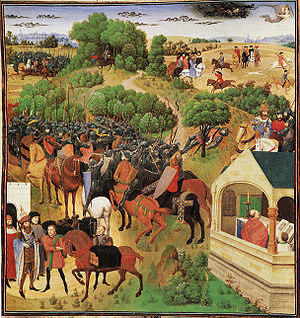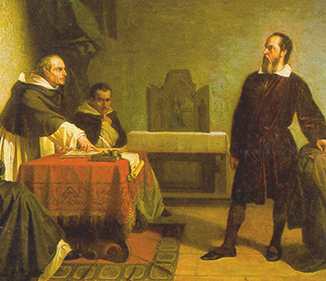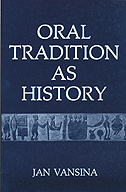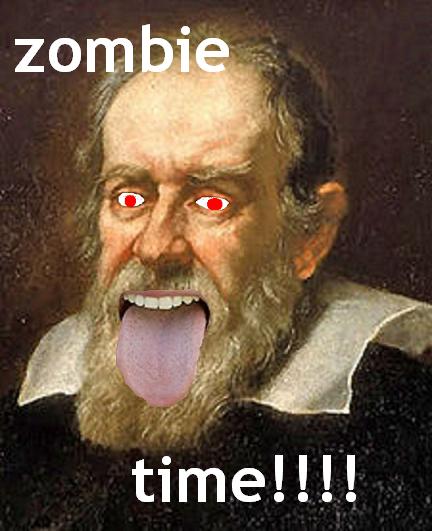Especially interesting in this regard is the origin of a certain tradition among the Hopi recounted on pp 19-20.
 |
| Photo ca. 1930. Note that the Hopi had begun adopting Plains Indian costumes by that time. |
Sometime between 1853 and 1856, as they were returning to their home on First Mesa from a visit to Fort Defiance, a party of ten Hopi were attacked by Navajos. At least four Hopi were killed, including the village chief. As a result a new clan took over the headmanship of the town. The battle led to retaliation, but eventually peace was concluded and a boundary between Hopi and Navajo was agreed on. The new boundary passed close to the spot of the ambush.
So much for history. Two versions of the event were recorded by anthropologists in 1892, just under forty years later. One was a bare recital of the facts. The other was a memoir by Djasjini who had been a survivor of the attack. His account is more detailed, but is still essentially a narration of events. A second survivor, Hani, had been a boy in 1853/6, badly wounded, but survived. By 1892, he had become chief of the Singer Society and directed the Wuwutcim ceremony at which the first, bare-bones account had been recited. Perhaps he had been the reciter.
A third version was published by a Hopi in 1936, some eighty years after the events and forty-four years after the original recordings. The story is now markedly different in character. The Hopi have gone to Fort Defiance because two men in love with the same woman, decide to show their bravery by sacrificing themselves to be killed at the boundary so that the boundary would be marked forever as sacred. The whole thing is predestined, as attested by the appearance of Eagle and Rabbit. The wounded boy Hani is now the hero of the story and idealized to recall the little Twin War Gods of Hopi myth.
IOW, the story has been retrofitted into a pre-existing mythos of other stories and traditions. The story was now an explanation of why the boundary was where it was, why there had been a change in leadership, and why the present leadership was right and true and good. It became a shared story because these things must never be forgotten.
Historical Consciousness
John Lukacs liked to use the phrase "historical consciousness," which he thought was increasing during modern time. It refers to knowledge of the past as past. Vansina explains that this sort of thinking -- linear change, chronology -- provides many accounts: a wealth of detail regarding the present. But beyond a point accounts become sparse, the names in the genealogies become few. Then, for the remote past -- "origin time" -- the accounts once more become plentiful and detailed. The origin time accounts are myth; that is, the social charter of the society.
In the genealogy of O Flainn of Sil Maelruain in O'Hart's Irish Pedigrees, the more recent generations are complete, and the most ancient names follow the annals. But in between there are simply not enough generations listed to cover the number of years involved!
Beyond a certain depth of time -- which differs for different societies because time is reckoned in generations or other social constructs, rather than in sun-circuits -- chronology can no longer be kept. Accounts fuse and either drop back into Origin Time, where they are assigned to a Culture Hero, or they are forgotten. Vansina calls this
The Floating Gap
But it might be called the Floating Horizon, that is, the horizon of historical consciousness. Within this horizon, actors are real people with complex motives dealing with a complex cultural context. Beyond this horizon, actors become archetypes with simple motives dealing with a black-and-white cultural contests that matters greatly to the story-tellers.
 |
| Pierre Paul François Camille Savorgnan de Brazza |
Among the Tio of the Congo ca. 1880, the horizon lay at ca. 1800. By 1960, it lay at 1880. Had the Tio remained completely oral, the arrival of de Brazza in 1880 would now have become timeless myth. As it is, writes Vansina, he has become a Culture Hero -- but one who can still be dated.
So does the advent of written culture abolish the floating horizon?
Yes and No
The horizon is at least potentially eliminated among professional historians, who familiarize themselves with the documentation of the era which they study. In the primary documents one can find the complexity and humanity of the actors and their circumstances. To some extent, those who read the historians can also accomplish this.
But who has time to read all that? Have you read the accounts of the Warren Commission? The primary sources for the attack on Ft. Sumter? The poetry of Eustace Dechamps? Most of us must depend on accounts that are little different from oral traditions.
The Shipwrecks of Time
Francis Bacon once wrote (in The Advancement of Learning) that “Antiquities are remnants of history which have casually escaped the shipwrecks of time.” That is, what we have of the past is only what has survived haphazardly. It is not even a random sample (which means that without "external information" we cannot draw inferences about the whole of society from the data). As we go further back in time, the survivors of the shipwrecks become fewer and fewer, and their reliability becomes more and more questionable.
For recent times, where there are many accounts, we can weigh one account against another, consider the agendas the writers may have had, and so on, and at least approximate to the truth. But when there are only three surviving monuments from the reign of a particular pharaoh, and those built under the pharaoh's direction, are we getting the truth, the whole truth, and nothing but the truth?
I will suggest, blushingly, that for us the floating horizon lies at about 300 years in the past.
 |
| King Art |
 |
| Big Chuck instructing Pious Lou |
However, unlike Arthur, some histories touching on Charlemagne have survived the shipwrecks of time: The Life of Charlemagne by his hero-worshiping minister Einhard, who wrote in imitation of Suetonius' Life of Augustus; a less reliable account by the Monk of St. Gall (assumed to be Notker the Stammerer. There is also the Annales Regni Francorum, which were the court chronicles. So we can to some extent separate the history from the myth from the history of the myth.
Hruoland
 |
| Medievals often portrayed multiple events on one canvas. This one shows eight episodes in the Song of Roland |
DCCLXXVIII [778]. Tunc domnus Carolus rex iter peragens partibus Hispaniae per duas vias; una per Pampilonam, per quam ipse supradictus magnus rex perrexit usque Caesaraugustam [Zaragoza]. Ibique venientes de partibus Burgundiae et Austriae vel Baioariae seu Provinciae et Septimaniae et pars Langobardorum; et coniungentes se ad supradictam civitatem ex utraque parte exercitus. Ibi obsides receptos de Ibin al Arabi et de Abutauro et de multis Sarracenis, Pampilona destructa, Hispani Wascones [Basques] subiugatos, etiam et Nabarros, reversus in partibus Franciae.No mention of the ambush, or Roland. Here is Einhard (in English):
In the midst of this vigorous and almost uninterrupted struggle with the Saxons, he covered the frontier by garrisons at the proper points, and marched over the Pyrenees into Spain at the head of all the forces that he could muster. All the towns and castles that he attacked surrendered. and up to the time of his homeward march he sustained no loss whatever; but on his return through the Pyrenees he had cause to rue the treachery of the Gascons. That region is well adapted for ambuscades by reason of the thick forests that cover it; and as the army was advancing in the long line of march necessitated by the narrowness of the road, the Gascons, who lay in ambush [778] on the top of a very high mountain, attacked the rear of the baggage train and the rear guard in charge of it, and hurled them down to the very bottom of the valley. In the struggle that ensued they cut them off to a man; they then plundered the baggage, and dispersed with all speed in every direction under cover of approaching night. The lightness of their armor and the nature of the battle ground stood the Gascons in good stead on this occasion, whereas the Franks fought at a disadvantage in every respect, because of the weight of their armor and the unevenness of the ground. Eggihard, the King's steward; Anselm, Count Palatine; and Roland, Governor of the March of Brittany, with very many others, fell in this engagement. This ill turn could not be avenged for the nonce, because the enemy scattered so widely after carrying out their plan that not the least clue could be had to their whereabouts.This is the only mention of Hruolandus in historical documents. Roncevaux is not mentioned. Einhard was in-the-know, being a friend of Big Chuck and all; but here's the rub. His Life of Charlemagne was one of the most popular books of the Middle Ages and many copies were made -- by hand. There are nine in various collections. Not all of the copies mention Roland; and the most important copies were made in the 11th century, after the pop tunes celebrating Roland had become common. And on one manuscript, the copyist notes that Einhard "forgot" to mention events that everyone knew. It is at least possible that the only mention of Roland -- simply that he died in the ambush -- was inserted into the text by a later copyist who was "correcting" an omission, and all copies thereafter repeated the insertion. (The songs, btw, replace the Basques with the Saracens, so it would fit the medieval templates.)
So was there a Roland at all? Did he die in the Basque ambush and move from history into legend? Or was he like Lancelot, an invention of the troubadours who in this case wound up inserted into a history? Unless more shipwrecks are discovered, how are we to know?
And Three Hundred Years Ago
from now takes us back to ca. 1700. Have the real historical personages of the 1600s shifted from history to legend (except among professional historians of the period)?
You betcha. Galileo has become a Culture Hero, simplified from human being to archetype, and the events around him have been caricatured in a legend supporting the foundation myths of the Modern Ages. All the others who did important work -- Harriott, Fabricius, Scheiner, Kepler, et al. -- have faded and their accomplishments have been assigned to the Culture Hero. Not by those who have studied the period, but by the culture-at-large. Just as the ambush of the Hopis by the Navajos was reimagined as a symbolic encounter whose meaning related to 1936 social relations, so too has the story of Galileo been incorporated as the Genesis Myth of the Modern Ages.
 |
| Note the iconic poses to support the Origin Myth. The painting dates from 1857, of course, when the War Between Science and Religion™ was invented. |
Note of the Foot: It's not only Galileo who has become legend. Think of the Pilgrims, of Jamestown and Pocahontas, the pirates of the Caribbean, the Three Musketeers, and other matters of the 1600s. How do they appear in history versus popular imagination?
I Told You That To Tell You This
I am now 41,000 words into a new novel entitled The Shipwrecks of Time. Woo, as they say, hoo.
Part I Old Books
Presently, it is 1966, Frank is meeting with Sorgensson in Aachen, Wilma and Carole have finally become friends, the Negroes in Milwaukee are becoming restless, and US troops recently engaged in direct combat at a place called Ia Drang. Maybe, just maybe, Frank has gotten a lead on the Peruzzi Manuscript. Wilma is finishing her concordance of the Matter of France by trying to identify actual historical figures that may have inspired the characters and events in the chansons. Ed White has walked in space.
If only they can figure out why other researchers looking for the Peruzzi Manuscript have from time to time wound up dead.
Part II Old Film
Part III Old Bones
Wouldn't you like to know... mwahahah
So would I, actually.





This makes proving the historicity of the Gospels vastly important.
ReplyDeleteThere's an example of an event becoming legendary withing months. Just two months after the Fukushima meltdowns, I read a blog post claiming that THEY said there was no meltdown but with no quotes from THEM.
ReplyDeleteI liked the way the biggest earthquake and tsunami in modern Japanese history, and the hundreds of deaths on bullet trains and elsewhere, took second billing to the difficulties at the power plant. MIT was a lonely voice of sanity, running a clearinghouse for the actual problems there, versus the vapors of the main stream media.
ReplyDeleteOh, cool! That makes perfect sense of what caused the horrible "social studies" history I got in school-- they were trying to correct this story-thing, but ended up just shoving stuff into a different cultural myth.
ReplyDeleteThe more I think about it, the more I think Mr. Pratchett is right about us being "storytelling man" instead of "thinking man"!
Great essay. One thought:
ReplyDelete"That is, what we have of the past is only what has survived haphazardly. It is not even a random sample"
Maybe I'm nuts or a victim of wishful thinking, but I've long imagined that the stuff that survives the shipwreck is biased toward what the people at the time, and their descendents, thought good or worthy - thus, we have the Iliad and the Odyssey, the most highly praised works by Homer, but none or little of anything else by him; we have lots of pretty (and sturdy) old buildings, but fewer ugly old buildings (leading to the likely wrong idea that people built only lovely buildings in the old days!). We (I) imagine that we have the best of Sophocles's plays - that, what with the cost of sheepskin and copying, the scholars and monks picked the best stuff to save.
Not that lots of good stuff didn't get lost or that some lame stuff didn't sneak through - just that there's a bias towards good stuff. We can only hope.
Joseph M - a thought: maybe we are more likely to get what was loved? I like the poetic notion that love might be a survival trait for historical stuff....
ReplyDelete@Joseph
ReplyDeleteGood point. We know that the medievals favored Greek works on logic, math, and natural philosophy over works of literature and ritual. Then too those things which were better thought of would tend toward more copies being made, and therefore more likely that at least one would survive. We know that Homer wrote something called Margites, but it ain't around. Neither is Shakespeare's Cardenio.
OTOH, we have enormous amounts of documentation on trivial departmental transactions of modern government bureaus. Hmm.
Say you have a class of 100 or so 16 year olds and you're the instructor in "Western Civilization." You have them for 3 out of every 4 school days - maybe 120 days over 9 1/2 months, for 50 minutes each time. You've been told that the curriculum for the course starts in 1400 A.D. (oops, I mean C.E.). I know the Renaissance was the "rebirth" of something or other, but let's move on. Waddya gonna cover? With what material?
ReplyDeleteWaddaya say, folks? Can we help the eponymous Mr Flynn? He is a history teacher with unsavory relatives.
Delete+ + +
Is it an AP class?
Random thoughts:
I would start with some sort of scroll across the screens of their brain summarizing Parts I and II, or at least Part II. Otherwise, none of Part III will make any sense. It's like watching Return of the Jedi without having seen A New Hope or The Empire Strikes Back. Come to think of it, the Modern Ages are The Empire Strikes Back.
The 1400s are covered, at least for Burgundy and France, in Huizinga's The Autumn of the Middle Ages. That's college level, but there are parts. Study question: are we now in the Autumn of the Modern Ages? In what way did modernity differ from medievalism? In what way is post-modernity differing from modernity.
"The Modern Age had a number of distinct dimensions. It was the Age of Europe, the Age of the Bourgeois, of the State, of Money and Industry, of the City, of Privacy, Family, and Schooling. It was the Age of the Book, of Representative Art, of Science, and of Secularism. All of this began to brew up five hundred years ago, and all of it is losing its fizz today." -- M.F.Flynn, "The Autumn of the Modern Ages," (in draft)
I might be inclined to track each of these topics through the chronological periods: 15th cent., Renaissance, Scientific Revolution, "Age of Reason," etc. Listen to the music of each period. Look at the art of each period. For science, Toby Huff's books, The Rise of Early Modern Science and Intellectual Curiosity. For religion: the breaking of the Church by the Kings (the Great Schism, Concordances, outright nationalization, adopt-a-heretic)
http://m-francis.livejournal.com/171684.html
Heh.
I'm a big fan of time-lines with important/interesting things noted out, myself. Not for direct use in teaching, but around the edge of the classroom-- I know that I got interested by spotting something on similar displays more often than I got interested by what the teacher was saying! (no offense to good teachers, there's a reason you're precious)
ReplyDelete